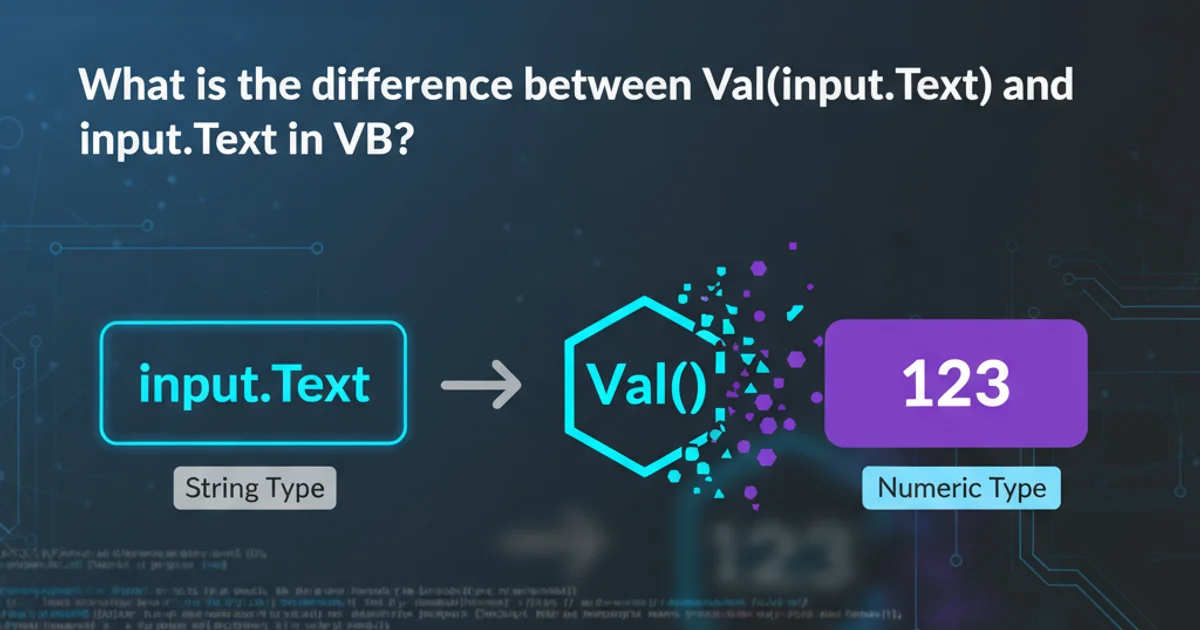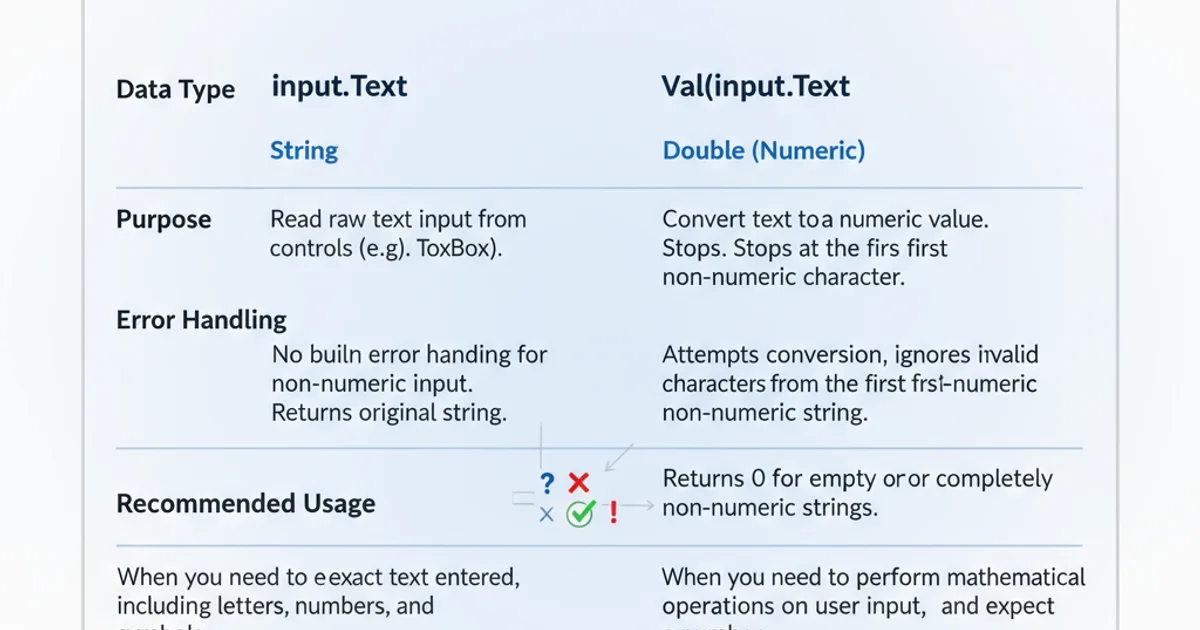What is the difference between Val(input.Text) and input.Text in VB?
Categories:
Val(input.Text) vs. input.Text in VB: Understanding Type Conversion and Data Handling

Explore the fundamental differences between using Val() for numeric conversion and directly accessing the Text property in VB.NET, and learn when to use each for robust application development.
In Visual Basic (VB), particularly in older versions like VB6 or VBA, and still relevant in certain contexts within VB.NET, understanding how to handle user input and convert data types is crucial. Two common ways to deal with text input from controls like TextBox are directly using input.Text and applying the Val() function, as in Val(input.Text). While both involve the text content of a control, their purpose and behavior are distinctly different, especially concerning data type conversion and error handling.
input.Text: The Raw String Value
The Text property of a control (e.g., TextBox.Text) simply returns the literal string content displayed within that control. This value is always of the String data type. When you access input.Text, you are getting exactly what the user typed or what was programmatically set, character for character, including any non-numeric characters, spaces, or formatting. This is the most direct way to retrieve the content of a text-based input control.
Dim userInput As String
userInput = TextBox1.Text
' If TextBox1.Text is " 123abc ", userInput will be " 123abc "
' If TextBox1.Text is "Hello World", userInput will be "Hello World"
Console.WriteLine($"Raw input: {userInput}")
Accessing the raw string content using the Text property.
Val(input.Text): Numeric Conversion with Caveats
The Val() function is a legacy VB function designed to extract a numeric value from a string. It reads characters from the beginning of the string until it encounters a non-numeric character (other than a space, tab, or comma, which it ignores) or the end of the string. It then returns the numeric value it found as a Double data type. If the string begins with non-numeric characters, Val() returns 0.
Val() function is generally discouraged in modern VB.NET development due to its limitations and potential for unexpected behavior. It does not handle regional settings for decimal separators (e.g., comma vs. period) and stops parsing at the first non-numeric character, which can lead to data loss or incorrect conversions.Dim numericValue As Double
' Example 1: Valid numeric string
TextBox1.Text = "123.45"
numericValue = Val(TextBox1.Text) ' numericValue will be 123.45
Console.WriteLine($"Val(""123.45""): {numericValue}")
' Example 2: String with leading non-numeric characters
TextBox1.Text = "abc123"
numericValue = Val(TextBox1.Text) ' numericValue will be 0
Console.WriteLine($"Val(""abc123""): {numericValue}")
' Example 3: String with trailing non-numeric characters
TextBox1.Text = "123abc"
numericValue = Val(TextBox1.Text) ' numericValue will be 123
Console.WriteLine($"Val(""123abc""): {numericValue}")
' Example 4: String with spaces and commas (ignored by Val)
TextBox1.Text = " 1,234.56 "
numericValue = Val(TextBox1.Text) ' numericValue will be 1234.56
Console.WriteLine($"Val("" 1,234.56 ""): {numericValue}")
Demonstrating the behavior of the Val() function with various inputs.
Modern VB.NET: Preferred Conversion Methods
For robust and reliable type conversion in VB.NET, it's highly recommended to use the TryParse methods (e.g., Integer.TryParse, Double.TryParse, Decimal.TryParse) or direct conversion functions like CInt, CDbl, CDec, or Convert.ToDouble. These methods offer better control over error handling, support different number formats based on regional settings, and provide clearer indications of successful or failed conversions.
flowchart TD
A["User Input (TextBox.Text)"] --> B{"Is numeric conversion needed?"}
B -->|No| C["Use input.Text (String)"]
B -->|Yes| D{"Legacy VB6/VBA?"}
D -->|Yes| E["Val(input.Text) (Double)"]
D -->|No (Modern VB.NET)| F{"Robust Conversion?"}
F -->|Yes| G["Integer.TryParse / Double.TryParse / Decimal.TryParse"]
F -->|No (Direct Conversion)| H["CInt / CDbl / CDec / Convert.ToDouble"]
G --> I["Handle success/failure"]
H --> J["Handle potential exceptions"]
E --> K["Be aware of Val() limitations"]
C --> L["Process as String"]
I --> M["Use converted numeric value"]
J --> MDecision flow for handling user input and type conversion in VB.
Dim inputString As String = TextBox1.Text
Dim parsedInteger As Integer
Dim parsedDouble As Double
' Preferred method for integers
If Integer.TryParse(inputString, parsedInteger) Then
Console.WriteLine($"Successfully parsed integer: {parsedInteger}")
Else
Console.WriteLine($"'{inputString}' is not a valid integer.")
End If
' Preferred method for doubles
If Double.TryParse(inputString, parsedDouble) Then
Console.WriteLine($"Successfully parsed double: {parsedDouble}")
Else
Console.WriteLine($"'{inputString}' is not a valid double.")
End If
' Direct conversion (can throw exceptions if invalid)
Try
Dim directConvertDouble As Double = CDbl(inputString)
Console.WriteLine($"Directly converted double: {directConvertDouble}")
Catch ex As FormatException
Console.WriteLine($"Error converting '{inputString}' to double: {ex.Message}")
End Try
Using TryParse and direct conversion methods in modern VB.NET.
TryParse methods when converting user input to numeric types. They provide a safe way to attempt conversion without throwing exceptions, allowing you to gracefully handle invalid input.Summary of Differences
The core difference lies in their purpose and behavior regarding data types and error handling. input.Text provides the raw string, while Val(input.Text) attempts a numeric conversion with specific, often undesirable, parsing rules. Modern VB.NET offers far superior and safer alternatives for type conversion.

Key differences between input.Text and Val(input.Text).